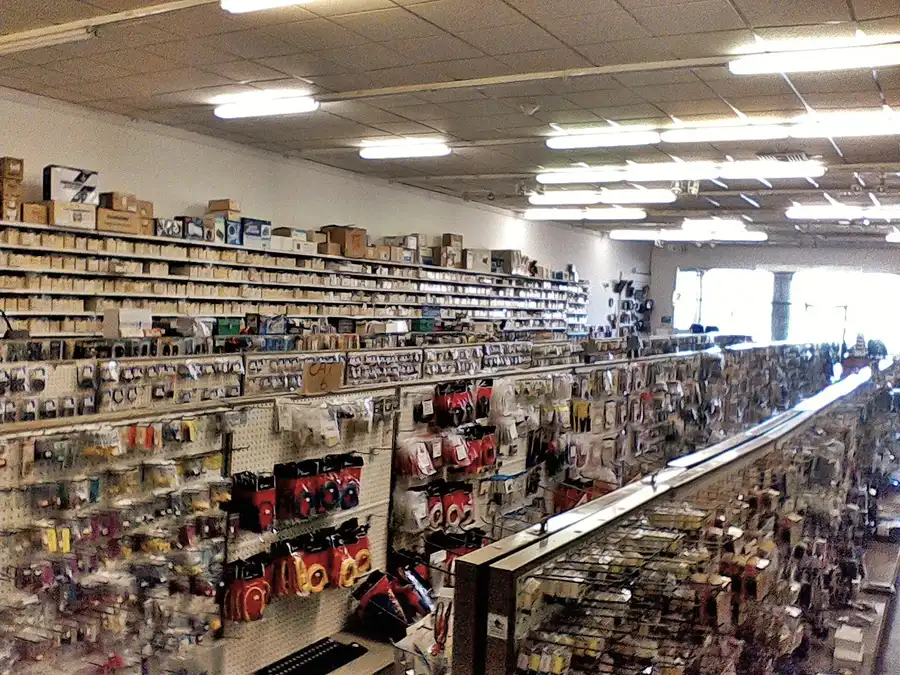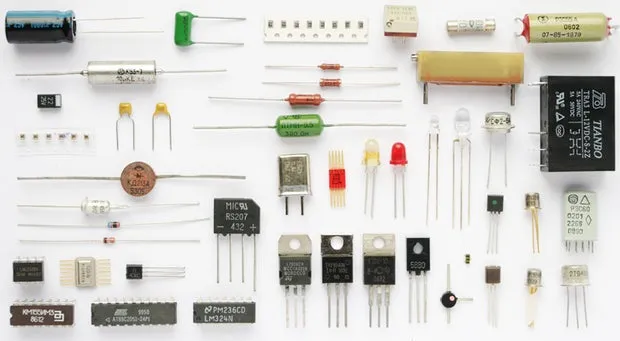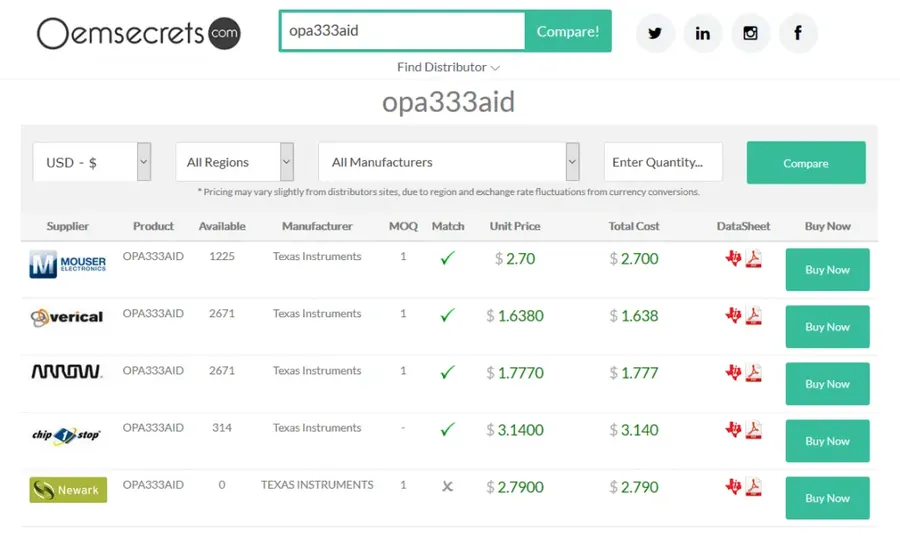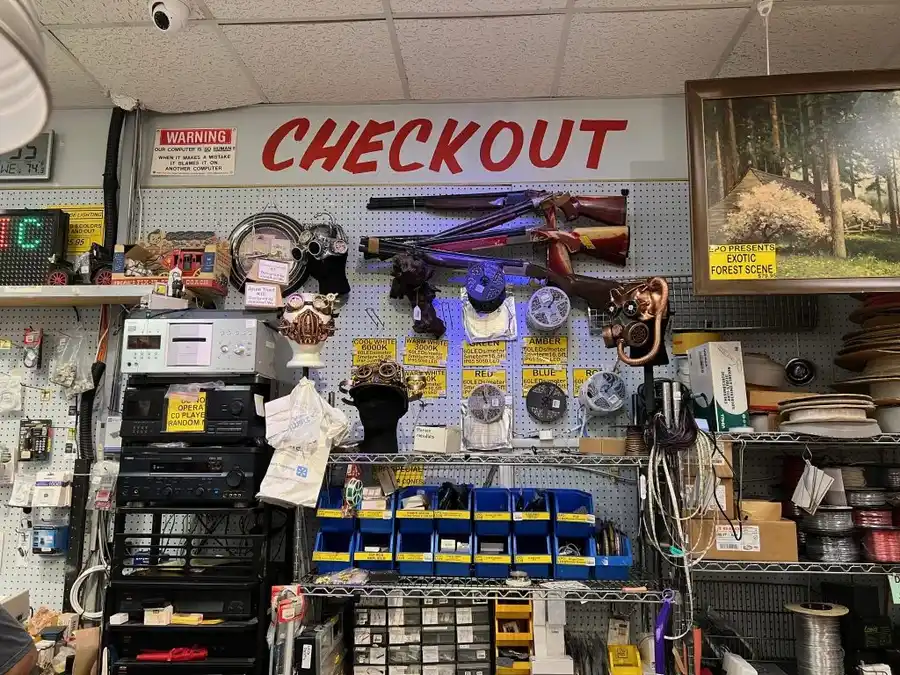Find Reliable Electronic Parts Supplier Near You: A Comprehensive Guide

In today's technology-driven world, access to reliable electronic components is crucial for innovation and repair. Whether you are a hobbyist building a robot, a student experimenting with circuits, or an engineer working on a complex project, finding a dependable 'electronic parts supplier near me' can save time and effort. This article guides you through the best ways to locate reputable suppliers, ensuring your projects are always powered with the right components, and connects daily life with technology by providing resources to obtain the necessary parts.
Understanding Your Needs: What Components Do You Require?
Before embarking on your search for an 'electronic parts supplier near me,' a crucial first step is to meticulously define your specific component requirements. This involves identifying the precise types of electronic parts needed for your project, whether they are standard, readily available components, or more specialized items. A well-defined list will significantly streamline the supplier selection process, ensuring you find the right source efficiently.
This section guides you to define the specific electronic parts your project requires. Accurate identification of components is key to a successful search.
- Common Components
These include basic elements like resistors, capacitors, and diodes. They are frequently used in various circuits and are typically readily available from most suppliers. - Specialized Components
This category covers more advanced parts such as microcontrollers, sensors, and various types of displays (LCD, OLED). These require a more targeted search, as not all suppliers carry them. - Integrated Circuits (ICs)
ICs range from simple logic gates to complex microprocessors. Identifying the specific IC part number and function will be critical.
| Component Category | Examples | Typical Use Cases |
|---|---|---|
| Passive Components | Resistors, Capacitors, Inductors | Current limiting, Energy storage, Filtering |
| Semiconductors | Diodes, Transistors, MOSFETs | Rectification, Amplification, Switching |
| Integrated Circuits | Microcontrollers, Op-Amps, Logic Gates | Control, Signal processing, Data manipulation |
| Sensors | Temperature sensors, Pressure sensors, Light sensors | Environmental monitoring, Measurement, Data collection |
| Displays | LCDs, OLEDs, LED Displays | Visual output, User interfaces |
| Connectors | Headers, Terminals, Cables | Interconnection of circuit components |
Knowing the precise specifications (e.g., resistance value for resistors, capacitance value for capacitors) and packaging requirements (e.g., surface mount vs. through-hole) is crucial for ensuring compatibility and avoiding errors in procurement. This also contributes to efficient use of budget.
Local Retail Options for Electronic Parts

For those seeking immediate access to electronic components, local retail options provide a tangible solution. These establishments range from large retailers with limited selections to specialty shops dedicated to electronic parts and tools, offering the advantage of inspecting items before purchase and taking them home the same day.
This section details the types of local retailers you might find, considerations when shopping in person, and specific advantages and disadvantages.
- Types of Local Retailers
Understanding the landscape of local options is essential for targeting your search: * **Large Retailers:** These stores often have a limited selection of basic components like resistors, capacitors, and some basic ICs. They cater to general consumer needs rather than specialized electronic projects. Examples include stores that also sell tools, hardware, and general electronics. * **Specialty Electronic Shops:** These stores are dedicated to serving hobbyists, engineers, and other professionals with extensive selections of components, including microcontrollers, sensors, displays, and more. They typically offer tools, development kits, and project boxes, along with staff that may have more technical knowledge. * **Hobby Shops:** While hobby shops may carry a narrower range, they will have commonly used components for building small electronics, and can offer project ideas as well as parts. - Advantages of Shopping Locally
Choosing a local retail supplier offers multiple benefits: * **Immediate Availability:** You can purchase parts immediately and start on your project, with no wait for shipping, especially useful for time sensitive or urgent projects. * **Physical Inspection:** You can examine the quality of parts before buying, checking for physical damage, correct sizing, and pin configuration. This provides a level of quality assurance not available with online purchases. * **Instant Gratification:** The ability to complete a project phase immediately without any delays caused by shipping or lost packages. * **Potential for In-Person Support:** You can interact with staff and gain advice for selection, or for troubleshooting. Staff at dedicated electronic stores can also have expert advice. - Disadvantages of Shopping Locally
While there are benefits, local retail also comes with drawbacks: * **Limited Selection:** Compared to online distributors, local shops may have a limited inventory, meaning you might not find all the specific parts required for your project. * **Higher Prices:** Local stores often have higher prices to cover operating costs such as rent, utilities, and inventory overhead. * **Limited Operating Hours:** Retail stores have operating hours, limiting your shopping flexibility compared to online suppliers which can be accessed 24/7. * **Inconvenient travel:** Travel time and the need to factor this in before the purchase.
| Feature | Local Retail Options | Online Distributors |
|---|---|---|
| Availability | Immediate, during operating hours | Typically 1-5 days shipping |
| Selection | Limited, depending on the store | Vast, often more comprehensive |
| Price | Generally higher due to overheads | Usually more competitive, better prices |
| Inspection | Parts can be physically checked | No pre-purchase physical inspection |
| Expertise | Store employees or electronics specialists available for advice | Customer service online may not have expert advice. |
| Convenience | Requires travel to physical store and adhering to store hours. | Access anytime anywhere |
Online Electronic Parts Distributors: A Broad Selection

Online electronic parts distributors provide access to a vast inventory of components, often exceeding what is available at local brick-and-mortar stores. This offers a convenient and efficient way to source electronic parts, with the ability to compare prices and specifications from various suppliers.
These distributors act as intermediaries between manufacturers and end-users, offering various components from different brands and manufacturers under one platform. This centralized approach makes it easy to locate a specific component and provides information that may not be readily available elsewhere.
- Extensive Selection
Online distributors typically stock a wide range of electronic components, from basic resistors and capacitors to advanced microcontrollers and sensors. - Price Comparison
It is easy to compare prices across different distributors for the same part. This helps in finding the best deals. - Detailed Specifications
Most online distributors provide detailed datasheets and technical specifications, aiding in component selection. - Quick Shipping
Many online distributors offer fast shipping options, potentially getting components to you quicker than traditional methods. - User Reviews and Ratings
Many platforms allow users to rate and review suppliers which helps in gauging their reliability.
| Factor | Description | Consideration |
|---|---|---|
| Shipping Times | Delivery timeframes can vary between suppliers. | Check estimated delivery dates and choose options that meet project timelines. |
| Minimum Order Quantities | Some distributors have minimum order quantities for certain components. | Check the minimum order quantity to ensure they align with project requirements. |
| Supplier Reliability | The trustworthiness and reputation of the supplier. | Research customer reviews, ratings and certifications to assess the reliability of the supplier. |
| Returns and Refunds | Supplier policies regarding returns, warranty and faulty components. | Understand the terms and conditions of returns and refunds to ensure recourse if issues arise |
Key Factors When Choosing an Electronic Parts Supplier
Selecting the right electronic parts supplier involves more than just finding the lowest price. A comprehensive evaluation must consider several critical factors to ensure the quality, reliability, and success of your projects. Prioritizing these factors can mitigate potential risks and ensure consistent access to needed components.
Here's a detailed breakdown of the key considerations:
- Supplier Reputation
A supplier's track record is paramount. Look for established companies with positive reviews and a history of reliable service. Check for industry certifications and memberships. - Component Quality
The quality of parts directly impacts the performance and reliability of your electronics. Inquire about the manufacturer, certifications, and any quality control processes they have in place. Consider purchasing sample components to test before large orders. - Part Selection
A supplier with a broad selection of parts can fulfill many of your requirements, potentially reducing the need to work with multiple vendors. Check to ensure they regularly update their inventory with new and obsolete parts, especially if you work on long-term projects. - Shipping Speed & Costs
Timely delivery of components is vital for project timelines. Evaluate shipping options, transit times, and associated costs. Understand the cut off times for same day shipping. Consider express options for urgent needs. - Customer Service
Responsive and helpful customer support is important for resolving issues. Test responsiveness before committing large orders. Check if there are several contact methods (chat, email, phone). - Pricing
While price is important, focusing on the lowest price alone can be detrimental to quality. Assess the overall value offered, balancing price with quality and service. Compare pricing for your desired parts and quantities, with shipping costs included.
| Factor | Importance | How to Evaluate |
|---|---|---|
| Reputation | High | Check reviews, certifications, and years in business. |
| Quality | High | Inquire about manufacturers, standards, and quality control. Test samples. |
| Selection | Medium | Ensure it meets your needs, also check for inventory and new parts. |
| Shipping | High | Compare delivery times, shipping costs, and options. |
| Customer Service | Medium | Test their responsiveness via multiple channels before commiting to larger orders. |
| Pricing | Medium | Consider value, compare prices with other suppliers, including total cost with shipping. |
By carefully evaluating these key factors, you can build a reliable supply chain to support your electronic projects, ensuring both quality and timely delivery of components.
Comparing Local vs. Online Electronic Parts Suppliers

Selecting the right supplier for electronic components is crucial for the success of any project. This involves understanding the distinct advantages and disadvantages of both local brick-and-mortar stores and online distributors. The optimal choice often depends on the specific needs of the project, including urgency, budget, and the variety of components required.
| Feature | Local Suppliers | Online Suppliers |
|---|---|---|
| Availability | Immediate; parts can be picked up right away. | Dependent on shipping time; may take a few days or more. |
| Inspection | Parts can be visually inspected before purchase. | Parts cannot be physically inspected prior to purchase; rely on descriptions and images. |
| Selection | Usually limited to common components; may not have specialized parts. | Very broad; offers a wide variety of components, including specialized parts. |
| Pricing | Often higher due to overhead costs and limited competition. | Generally more competitive pricing; better bulk purchase options may be available. |
| Customer Service | Can offer in-person support and immediate assistance. | Customer service is usually online or via phone; may take longer to resolve issues. |
| Minimum Order Quantities | Typically lower; good for small or one-off projects. | May have minimum order quantities; may not be ideal for very small projects. |
The selection between local and online vendors should always consider the implications for project timelines and budgets. For projects with strict time constraints, local suppliers offer immediate access to components, ensuring that project progress isn't delayed by shipping times. On the other hand, projects that don't face tight deadlines or require a wide selection of parts may benefit from the broad inventory and potentially lower prices of online suppliers.
Advantages of Local Electronic Parts Suppliers
- Immediate Access
Parts are available for immediate pickup, reducing project delays. - Physical Inspection
Components can be inspected before purchase, which ensures quality and correctness. - In-Person Support
Local stores offer the benefit of in-person support, allowing for immediate help and personalized service. - Lower Minimum Order Quantities
Ideal for small projects or hobbyists needing only a few components.
Advantages of Online Electronic Parts Distributors
- Vast Selection
Online distributors offer a comprehensive selection of parts, catering to both common and specialized needs. - Competitive Pricing
Online retailers often provide better prices, especially on bulk orders, due to lower overhead costs. - Convenience
Shopping can be done from any location at any time, offering significant convenience. - Detailed Specifications
Online stores typically offer detailed specifications and datasheets for components, which helps users in selecting the right parts.
Navigating the Electronic Parts Market

Understanding the landscape of electronic parts suppliers is crucial for sourcing components efficiently and cost-effectively. The market typically consists of three main types of suppliers: manufacturers, distributors, and retailers, each offering different price points, service levels, and product scope. Knowing the distinctions between these can help you select the most suitable source for your specific needs.
| Supplier Type | Description | Price Point | Customer Service | Typical Customer |
|---|---|---|---|---|
| Manufacturers | Companies that produce the electronic components. They may sell directly to businesses or through distributors. | Potentially lowest for large volume orders, but often have minimum order quantities. | Varies, may be limited to large accounts or direct clients. | Large manufacturers, OEMs |
| Distributors | Act as intermediaries, purchasing components from manufacturers and selling to a broader market. They hold large inventories and can fulfill various order sizes. | Competitive pricing, generally lower than retailers for medium to large orders. | Good support, often provides technical data sheets and application notes | Small to Medium sized businesses, educational institutions, research labs |
| Retailers | Sell components directly to the public, often in smaller quantities. They typically purchase from distributors. | Generally higher prices for small volume orders. | Usually have strong customer-facing service. | Hobbyists, individual makers, and small volume prototyping |
Choosing the right type of supplier depends on several factors including project scale, budget, and component type. Direct purchasing from manufacturers is usually viable for extremely large orders of standard items while distributors offer a cost-effective balance of price and selection, with retailers being ideal for small orders, prototypes or rare parts.
Frequently Asked Questions about Sourcing Electronic Parts Near You
Navigating the electronic parts market can be complex, and many questions arise when sourcing components. This section addresses common queries to help both hobbyists and professionals find the right 'electronic parts supplier near me' and make informed decisions.
- How do I locate a supplier that stocks specific electronic parts?
Begin by using precise search terms that include the component name and specifications. Check the supplier's website or catalog for detailed product listings. If uncertain, contact their customer service directly. Consider using parametric search filters on online platforms to narrow down your options based on component specifications. Always prioritize suppliers known for inventory accuracy. - What payment methods are typically accepted by electronic parts suppliers?
Most suppliers accept major credit cards, and many online distributors offer payment through platforms such as PayPal, Alipay or other third-party payment options. Some suppliers may also accept purchase orders or bank transfers for larger transactions. It's essential to confirm the available payment methods on their website or with their customer service before placing an order. - What steps should I take if an electronic part is faulty upon delivery?
First, inspect all parts immediately upon arrival. If a part is found to be faulty, contact the supplier within their specified return or warranty period. Usually, you will need to provide a detailed description of the issue, and sometimes photographic or video evidence. Follow their return process instructions for replacement or refund. Document all steps of communication and returns for reference. - How can I accurately assess the reliability of an electronic parts supplier?
Look for suppliers with a long-standing history and positive online reviews. Analyze their customer ratings and comments on review websites. Evaluate their stated quality assurance practices. Check if they have certifications or meet industry standards. Also, observe their response times to customer queries and their return and refund policies. - What are common electronic parts often used by hobbyists and professionals?
Common components include resistors, capacitors, diodes, LEDs, transistors, microcontrollers, integrated circuits, sensors, connectors, and various types of wiring. These are used in building a wide range of electronic projects and devices. For hobbyists, readily available development boards like Arduino and Raspberry Pi, along with sensors and actuators are very common. Professionals often use more specialized ICs, and high-reliability components such as ASICs, FPGA, or high precision sensors. - Is it better to use a local or online electronic parts supplier?
The choice between local and online suppliers depends on your specific needs. Local suppliers offer the advantage of immediate access and in-person inspection of components, useful for urgent needs or immediate prototyping. Online suppliers provide a much wider selection and often have more competitive pricing, especially for bulk orders. If timing is not a constraint, online might be preferable; for instant access and personal handling, local might be better. - Can I get volume discounts when purchasing electronic parts?
Yes, many suppliers offer volume discounts, also called bulk discounts, when purchasing a large quantity of components. These discounts can significantly lower the unit price, making bulk purchasing economical for projects involving numerous components. Always check with the supplier about available discounts and thresholds for bulk purchases.
Building a Reliable Electronic Parts Supplier Network

Establishing a resilient network of electronic parts suppliers is crucial for consistent project execution and mitigating potential supply chain disruptions. Relying on a single supplier can lead to project delays or increased costs if that supplier experiences issues. Diversifying your sources ensures you always have access to necessary components.
To achieve this, consider the following strategies:
- Primary and Backup Suppliers:
Identify both primary suppliers for your commonly used parts and backup suppliers for situations when the primary supplier is out of stock or has lead time issues. This ensures a fallback option for critical components. - Geographic Diversity:
Consider suppliers located in different geographical regions to minimize the impact of localized events like natural disasters or regional shipping delays. - Specialized Suppliers:
Include specialized suppliers in your network. Some suppliers may offer niche parts, or handle obsolete parts. These can often be more knowledgeable about specific product lines or specific industry segments. - Manufacturer Direct:
Where possible, create relationships with manufacturers directly. This can sometime eliminate the middle man and reduce cost and lead times. This is generally applicable when buying in larger quantities. - Regular Evaluation:
Regularly evaluate your suppliers performance, this allows to keep all of your supplier at a high service level. Evaluate areas such as, price competitiveness, stock levels, lead times, customer service and quality of parts.
Furthermore, maintaining an organized supplier database and tracking performance metrics is key to managing this network effectively.
| Supplier Factor | Importance | Evaluation Criteria |
|---|---|---|
| Supplier Reliability | High | Track record of timely delivery, quality parts, and good customer service |
| Price Competitiveness | Medium | Compare cost per unit across suppliers for the parts you purchase frequently. |
| Parts Availability | High | Monitor stock levels of frequently purchased items, lead times, and alternate parts where applicable |
| Customer Service Quality | Medium | Responsiveness to inquiries, handling issues, technical expertise. |
| Shipping & Handling | Medium | Shipping times, shipping cost, packaging quality. |
Tips for Saving Money on Electronic Components
Cost-effective sourcing of electronic components is crucial for both hobbyists and professionals. This section outlines practical strategies to reduce expenses without compromising quality, focusing on bulk purchasing, alternative brands, price comparison, and strategic discount hunting.
- Bulk Purchasing
Many suppliers offer significant discounts when you buy components in larger quantities. If your project requires multiple identical parts, consider buying in bulk to lower the per-unit cost. This strategy is particularly beneficial for commonly used components such as resistors, capacitors, and LEDs. - Exploring Alternative Brands
Consider using alternative brands that may offer the same performance and specifications at a lower cost. While some brand names may be preferred, many generic brands produce reliable components that can perform as well or nearly as well, particularly for non-critical applications. Refer to component datasheets to confirm compatibility. - Price Comparison Across Suppliers
Before settling on a supplier, compare prices from several different distributors. Prices for the same component can vary significantly, so shopping around can lead to substantial savings. Consider both local and online sources. Also factor in shipping costs when making a comparison. - Coupons and Discounts
Many suppliers, particularly online distributors, regularly offer coupons, discounts, and special offers. Sign up for newsletters or visit their websites frequently to take advantage of these opportunities. Timing your purchases with promotional periods can result in notable savings.
| Strategy | Description | Potential Savings | Considerations |
|---|---|---|---|
| Bulk Buying | Purchasing larger quantities of components | 10-50% per unit | Requires upfront investment and storage space |
| Alternative Brands | Using equivalent parts from different brands | 5-30% per unit | Must check datasheets for compatibility |
| Price Comparison | Comparing the same parts from various suppliers | 5-20% per unit | Time-consuming but worthwhile |
| Coupons and Discounts | Taking advantage of promotional offers | 5-15% total cost | Requires monitoring and timing |
By adopting these strategies, you can significantly reduce the cost of electronic components, enabling you to complete projects while remaining within your budget. Remember, cost-saving should not compromise the quality of your components, always double-check compatibility and the reputation of suppliers.
Finding a reliable 'electronic parts supplier near me' is vital for any project that involves electronics. By understanding your requirements, evaluating different types of suppliers, and considering all relevant factors, you can ensure a smooth supply of the components you need. This enables you to focus on your creativity, with confidence that your project will work well. Whether it's a local store or a robust online distributor, the key is to build a dependable supply chain. Keep searching for local suppliers, especially if you require quick sourcing or need parts right away.
 AnyPCBA
AnyPCBA